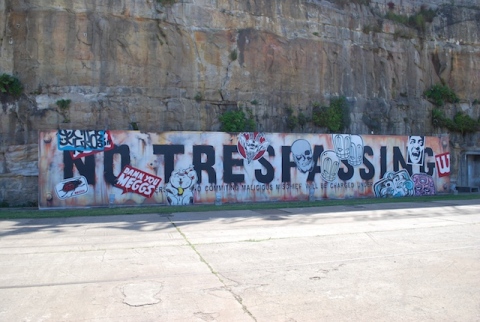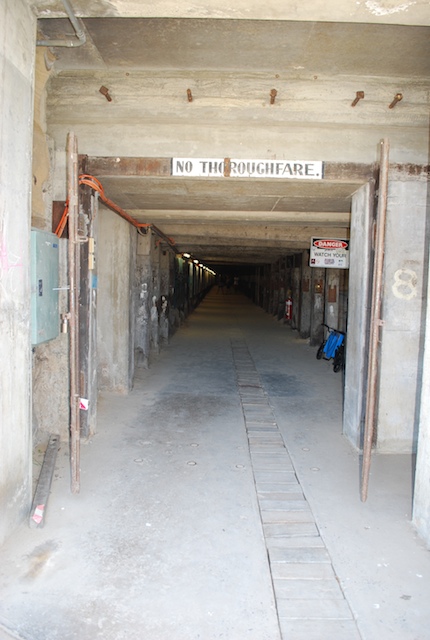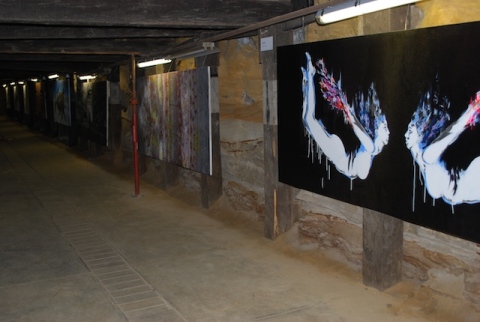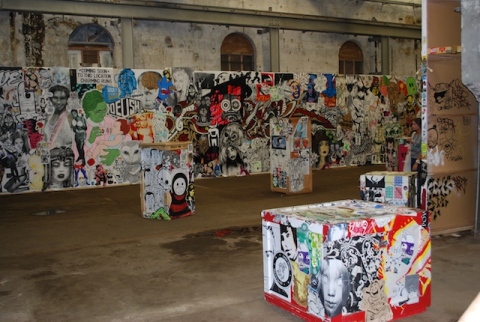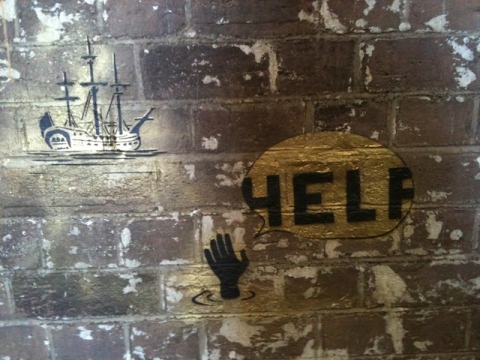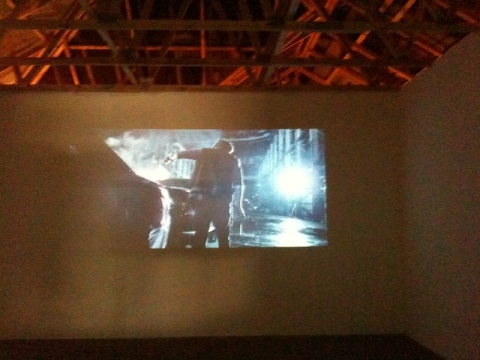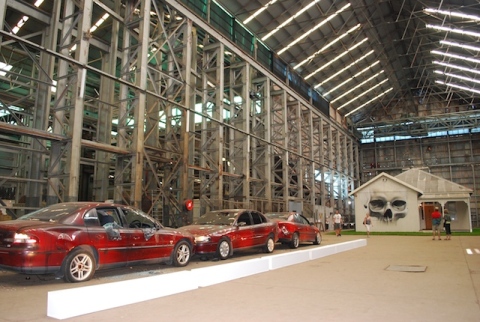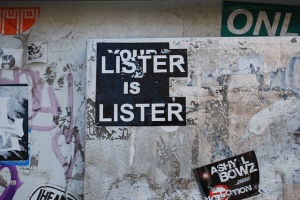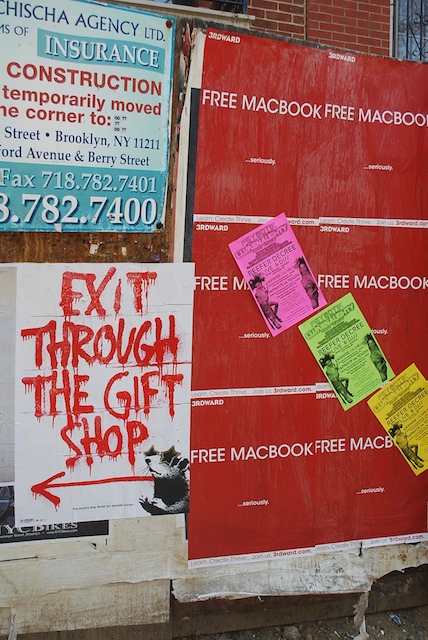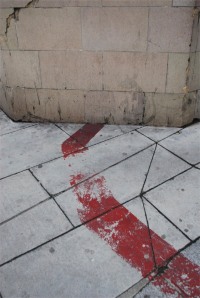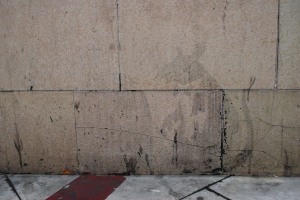Archive for the ‘Banksy’ Tag
Outpost!
I’m in Sydney, visiting Outpost: Art From the Streets, a street art festival being held on Cockatoo Island (I’ll be participating in a forum on The Politics of Street Art, along with Tom Civil, Mini Graff, and fellow academic Kurt Iveson, who writes the blog Cities and Citizenship).
Outpost, if you can believe the advertising, is the largest festival of street art to date in the southern hemisphere. It’s located on Cockatoo Island, in Sydney Harbour, and certainly this setting is one of the factors that make it a compelling experience. The island is the largest in Sydney’s gorgeous harbour, and has been a prison, a school, a jail, and a shipyard – its most recent incarnation prior to being abandoned as a kind of monument to a bygone age, with empty warehouses, rusting equipment and gigantic cranes dotted about. You can read about the island’s past and recent uses here.
It’s a clever choice as a location for a street art festival. The warehouses, factories, and alleyways provide an urban backdrop for the display of street artworks; street artists have often been drawn to abandoned buildings as sites in which to make art, although the resulting artworks are not easily viewed by members of the public. And in Australia, such locations have a specific history in the world of street art: during the early 2000s in Melbourne, the famous ‘Empty’ shows would take over abandoned or derelict buildings for the creation and temporary display of art.
Although Outpost draws on this rich history, it is, of course, is a world away from it in that it has corporate sponsorship, a merchandising outlet (for souvenir T shirts and caps), a couple of laid-back bars selling pizza and beer, and a well-organised staff who assist visitors in getting their bearings on the island, handing out maps and answering questions about the artists, and who oversee the queues waiting for ferries back to Circular Quay. To that extent, Outpost is definitely a product of a certain ‘mainstreaming’ of street art – which isn’t necessarily a bad thing; but visitors should go to see it aware that what’s been created is a somewhat sanitised and domesticated version of what street art can be.
Having said that, Outpost still makes for an extremely interesting and exciting event, and I would say if you can get to Sydney during November, or if you already live here, it’s a must-see.
So what’s there to be seen? Well dozens of artworks and installations, for one thing, many using the buildings and the geography of the island in really satisfying and innovative ways: Vexta’s enormous winged figure; Roa’s monochrome animals; the Everfresh piece mocking anti-graffiti laws; Lister’s giant inflatables painted with his now-signature faces and super-heroes; some cuprocking high above the bluff rising from the centre of the island; artworks lining a long tunnel through the bluff (evoking the tunnels and drains that so many artists have painted over the years, whether that be Melbourne’s Cave Clan or the artists in the Underbelly project in New York City).
Have a look:
One disappointing thing I was struck by is that many artists have been given hoardings to paint on, which are then displayed around the island. There’s a lot of uniformity to the size of these hoardings and in the way they are displayed, and I found myself wishing that there had been a tad more ingenuity in thinking through the question of how artists could display their abilities.
What else? Inside some of the buildings are various exhibits. One displays works from two private collections of street art, which means that you can see examples of work on canvas or print editions by Faile, Adam Neate, Antony Micallef, Swoon, Dolk, Lucy MacClauchlan and, of course, Banksy. There are over two dozen works by Banksy on display, and there’s an undeniable pleasure in seeing them, even though – or perhaps because – they are so well-known….
Other exhibit areas include Pastemodernism 3, a vast collection of examples of paste-ups, curated by Ben Frost:
It’s also nice to see a number of artists being given a lot of space in which to display their (very different work). Junky Projects, for example, has created some very large found-object sculpture:
And there’s a wonderful work by Tom Civil, ‘Let the Lightning Flash and the Thunder Roll’ showcasing his distinctive combination of political sensibility, political engagement, calligraphy, and composition:
But for me, the highlight of a day which had many pleasures was the piece by Kid Zoom. Inside one of the massive abandoned buildings on the island can be found ‘Home’, a work with several components, the most obvious of which is the large model of the house in which Kid Zoom grew up:
If you enter the building at the back, as I did, then you can immediately see that the rear of the house is open. Inside a video plays on a loop, displaying another element of the work, described as ‘the destruction of three Holden Commodores’. On a screen, we see a figure, in slow motion, approach three cars, all parked in a line, and meticulously lay waste to them in various ways: one is set spectacularly on fire; a mallet is used to smash their windscreens, side mirrors are kicked off. (Some of it reminded me of Shaun Gladwell’s amazing works ‘Storm Sequence’ and Stereo Sequences.) A soundtrack accompanies the film, combining industrial noise with slow repeated musical notes. The effect is mesmerising, overwhelming: when the film ended, several audience members who had been watching audibly exhaled…
And then, when the film ended, I walked around to the front of the house to discover that the three Holden cars are parked outside it, end-to-end, just as they appear in the film:
And then you realise that the film was made inside that same building, which brings the violence just watched on the screen into the building itself, and puts you in the position of being a witness to that destruction twice over: once on the screen, and then again as you stand next to the burned out shells of the cars.
It’s an incredibly powerful work, and it utilises the space brilliantly, both in its making and in its display. If there was nothing but Kid Zoom’s ‘Home’ on display at Outpost, it would be worth making the trip to Cockatoo Island for it alone; as it is, it’s the high point of an exhibition that, for good and ill, showcases many of the defining characteristics of the street art world today: its collectability; its proximity to advertising; its proximity to ‘vandalism’; its political nature; its too-often repeated visual tropes but also its sheer, undeniable aesthetic joys.
Exit Through the Gift Shop comes to Melbourne
For everyone living in Melbourne, you may well be aware of this already, but just in case, i thought i would mention the fact that Banksy’s movie, Exit Through the Gift Shop, is coming to town. As well as being a fascinating account of hype and marketing in the world of street art, it also contains some amazing footage of street art (and street artists in action) around the world – including several shots of the work of local artists such as Rone, Ash Keating and Vexta.
ACMI will screen Exit Through the Gift Shop from the 3rd of June for a full two week season. (You can check dates and times here.)
If you are living in Sydney, the movie is screening at the Sydney Film Festival on 2nd and 7th of June, but according to their website, the sessions are already sold out….
I’ve written previously about the movie – I saw it in April in New York and posted a two-part review of the film (here and here). I won’t repeat what I’ve already written about the film; you can check out those posts if you’re interested in my views on the movie.
In the interests of full disclosure, in the wake of the recent online debates about the differences, if any, between blogging and marketing, I should mention that Madman, who are distributing the movie in Australia, invited me to mention it on this blog. I’m not being paid to do so, and I wouldn’t make any mention of it if I thought the film was rubbish. It’s not rubbish, it’s well worth seeing, so I am happy to mention it here.
But in recent weeks there’s been a groundswell of awareness about the potential of blogs to influence consumption and opinion – the most acute version of this occurred in New York last month, and you can read here a thoughtful account of the implications of the way the Banksy film was promoted in the United States.
I don’t imagine that my opinions in this blog will exercise much influence at all over whether or not you go and see Exit Through the Gift Shop, but it’s only fair to mention the fact that I am also appearing on the panel discussing art, advertising and public space after the movie screening at ACMI on Sunday 6th June, and that the Friday 4th June screening of the movie is timed to facilitate your attendance afterwards, should you be interested, at a book launch taking place at Federation Square in the Atrium at 7pm – and that book is Street/Studio; the Place of Street Art in Melbourne (and I am a co-author of that book). More about the book soon!
So that’s the background to this post.
Is the film worth seeing?
Absolutely.
Even if you have no interest in street art per se, it’s still a fascinating documentary, with a great film-within-a-film narrative.
And if you are already interested in street art in general (or Banksy in particular), then it’s essential viewing. Funny, inspiring, provocative – it probably raises more questions than it answers, and it’ll produce endless hours of conversation about Banksy himself, about Shepard Fairey, Invader, and – more than anyone – about Thierry Guetta.
Who? See the film, and find out.
O Superman
Sometimes travel provides an occasion to reflect upon the place you’ve left behind… While I was in New York recently, there were two different kinds of ‘home’ that I felt conscious of having left.
One was England (or Britain, I suppose). I left Britain in 1995, when I moved to Melbourne, but New York this April was full of buzz about the release of Exit Through the Gift Shop, Banksy’s movie, which I have written about here and here already, and I certainly think of Banksy as a quintessentially English (or British) artist…
New York was also full of visual reminders of Melbourne, the city that became my adopted home. As I mentioned before, one of them was Meggs’s stickers, which I saw in many places around New York.
I’ve written about Meggs before (see here), and in that entry I was discussing his work in conjunction with that of Anthony Lister, an Australian artist from Brisbane, living in New York these last several years. There are several different consonances between these two in terms of their artistic preoccupations, but in terms of simple coincidence it was amusing that while I was in New York, Anthony Lister was paying a visit to Melbourne, where he had a show at Metro Gallery.
But it’s not as though Lister was entirely gone from New York. His stickers are still very much present on the streets:
And the front of Faile’s studio was adorned with this wonderful Lister painting:
Lister also had a solo show, How to Catch a Time-Traveller, at Lyons Wier Gallery in April, running simultaneously with the Melbourne show.
Meggs and Lister are linked by more than a common nationality; there’s a strong thematic link in their fascination with the superheroes of popular culture, and comics in particular. Both create painted works as well as their own versions of action figures, miniatures and busts. Both Meggs and Lister show superheroes as figures of crisis, barely holding themselves together in the face of unknown assailants or obligations.
But in representing these highly familiar figures away from the context of comics, their methods with paint are very different, however. Meggs uses a combination of stencils and techniques from graffiti art; Lister is evolving a style that recalls Francis Bacon’s way of blurring the painted figure to create a sense both of movement and of the disintegration of the self.
In Lister’s show at Lyons Wier, its title alludes to the idea that these figures are in motion – the artist is the one with the power to stop time, to freeze the disintegrating superhero for an instant, for our scrutiny. Lister’s had a prolific career on the street for a long time, and it’s fantastic to see his painterly skills evolving. Maybe Lister’s thematic will start to broaden a little so that it is no longer simply the superhero which is subject to examination. Charlie Isoe’s current show at Lazarides in London, while containing a lot of works that seemed to me to be somewhat similar, disappointingly, to Lister’s style, showed at least what can be achieved when a wider range of objects are brought into the paintings.
What next, Mr Lister? Can’t wait to see.
Art, Value and Banksy’s Rats in Melbourne – visit Hyperallergic
If you have been following the recent street art debacle in which Melbourne City Council ‘accidentally’ buffed one of Banksy’s rats in Hosier Lane in Melbourne, you might be interested in reading my account of this event, over on the excellent site Hyperallergic.
Banksy at the movies: Part II (Banksy’s hands)
Since the previous post, about expectations of what Exit Through the Gift Shop is about, turned out to be a long one, I thought I’d write a separate one dealing with what it’s not about.
So let’s go back to the second response that a lot of people seemed to have after seeing the movie – a feeling of surprise that it’s not ‘about’ Banksy, or at least not as much as they had expected.
It’s worth looking at this closely. Is the film ‘about’ Banksy? Well, the film is made by him, and thus it provides us with a text which tells us something about the artists and his concerns, just as his artworks, books and exhibitions do.
And then again, Banksy is in the movie: we see him in his studio; we see him stencilling; we see him with his crew of helpers creating the famous ‘vandalized telephone box’ in London (which goes on to sell for an extraordinary sum at auction); we see him installing a blow-up doll, hooded, shackled, and wearing an orange jumpsuit, at Disneyland, in a direct juxtaposition of American mass entertainment culture with the torture of detainees at Guantanamo. (All of these occurrences are filmed by Guetta.)
But of course, while all of these events are taking place, Banksy still withholds himself from any kind of identifying gaze – he wears the hood of his sweatshirt pulled over his head, his face is blanked by pixillation, his voice distorted (and his assistants’ identities are similarly masked).
So Banksy’s certainly in the movie, but he’s simultaneously on display and hidden from our view. But what we do see in plain sight are his stencils and his hands: as Banksy himself states in the film, ‘I told Thierry he could film my hands but only from behind’.
As he says these words in voice-over, the film shows us Banksy at work, cutting stencils (for one of his signature rats, to be put up on a wall in LA). And for me, that was one of the highlights of the film – watching those hands, whether at work on the stencil or gesturing along with the words spoken by Banksy’s distorted voice.
They’re slender hands, with long fingers. They’re the hands of an artist. What does the face matter, or the voice? Watch the film – and watch out for the scene of Banksy cutting stencils, with speed, and with great skill. That moment might not be central to the film, but it’s certainly what street art is all about.
Banksy at the Movies: Part I
I’m in New York City right now, and last night I attended a preview screening of Banksy’s film, Exit Through the Gift Shop. The film is being released in a number of US cities from April 16th and if you click here you can find a list of release dates, cities and theaters. (If you’re reading this in Britain, the film’s been out for a few weeks; if you’re reading this in Australia, be patient a little longer because the film will be released there in early June.)
Given the intense interest in Banksy as an artist and in the mystery of his identity, it’s inevitable that this film will attract a lot of attention. What’s as interesting as the movie itself is the range of responses that people are having to the film. Among those who’ve seen it so far, people speak positively of the film (as they should, since it’s a highly enjoyable documentary), but they also seem, first of all, surprised that it is more about Mr Brainwash (aka MBW aka Thierry Guetta) than it is about Banksy; and, second, disappointed that, because the film is more about Mr Brainwash, Banksy doesn’t reveal much of himself in the movie.
Let’s start with the first of those reactions, that the film’s not ‘about’ Banksy, which certainly raises the question of what the film is about. Well, the film operates on many different levels, and one of its main ones is the story of how street art took off, from being something with an intense local significance which was shared through the networks of the global street art community for the enjoyment of those who practice or appreciate street art, to became an entrenched part of the mainstream art world, whereby paintings (and artists) are commodified for profit.
To tell that story, the film focuses on Thierry Guetta’s transformation from amateur film-maker into artworld succes du jour, as a means of demonstrating both the possibilities open to anyone with the will to put up art and the (slightly frightening) logical consequences of those possibilities (for example, having people queueing for hours to get into your art show, simply because they’ve been told by the media that your art is important).
The film treads a clever and careful line between condoning and critiquing the commercialization of street art, as its embodied in Guetta’s transformation: it really is left up to the viewer to work out where you stand on the issue. In some ways, the film seems to be criticizing the people who have bought Mr Brainwash’s work for vast sums of money and who have contributed to his art world stardom, but, then again, isn’t this the same art world that has made stars of Shepard Fairey and Banksy and Blek le Rat? If we want to critique the art world, it must be a critique that can specify why Mr Brainwash’s stardom is problematic when that of the others is not.
So: how do we think through that problem? Is it because Mr Brainwash doesn’t make all of his art himself? Neither does Shepard Fairey nowadays, nor Banksy (both of whom have assistants – and we see some of Banksy’s assistants at work in the film), and neither does Jeff Koons, for that matter. Is it because Mr Brainwash’s work is derivative (his work repeats many of the devices used by Andy Warhol, Banksy, Fairey, Nick Walker, Blek…)? Well, that might be a better founded criticism, but it still requires us to think through its implications: each of those artists borrow from other artists and art movements, re-presenting certain tropes in order to create a new art idiom. Perhaps Mr Brainwash’s endless borrowing (what some would even call plagiarism) from the borrowers lacks aesthetic merit because it does nothing new – no new idiom emerges from his pillaging of pop culture and street art.
At any rate, I think these issues form the heart of what the film is about – and I’d back this up by referring you to the movie’s title. By calling his film ‘Exit Through the Gift Shop‘, Banksy is both having a sly dig at museum culture, which often cynically seeks to extract more money from visitors after they have viewed an exhibit, but he is also pointing out to us the direction that street art may be heading in, now that its commercialization is so advanced – the only ‘exit’ is to find a way through the endless consumption offered to us as a poor substitute for the art itself.
Street Art and the Museum Revisited: Banksy on the Inside*
In November last year, I wrote about the exhibition, Street Art, at the Tate Modern in London. Artworks by street artists have been exhibited in commercial galleries on and off for many years, but this was the first time that a museum had showcased work by urban artists such as Blu, Nunca and Faile. After visiting the exhibition, I wrote about how I felt disappointed that the Tate had confined its exhibition of the works to the outer façade of the building. Although this provided the selected artists with a massive ‘canvas’ to work on, it also meant that when the exhibition ended, the works were buffed by the museum just as a council would buff these works if they appeared on walls around a city.
Less than a year after the exhibition on the walls of the Tate Modern, street art has been brought into a museum space, and to an extent that I think it’s fair to say could not have been predicted. Bristol City Museum and Art Gallery has just opened its summer exhibition, Banksy versus Bristol Museum.
The title of the show acknowledges the tension that exists when street art is displayed indoors, or when works that some might say are best viewed in passing, on a street wall, are instead placed inside the rarefied space of a gallery. The exhibition’s context is implied as a contest, a struggle between Banksy, artist of and for the people, and all that is represented by a council-funded, conventional museum (and remember that Banksy once painted ‘Mind the crap’ on the steps of Tate Britain, in a nose-thumbing gesture at the hierarchies of art institutions).
To a certain extent that is all true: much ink has been spilt and many blog entries posted about whether street art ‘belongs’ indoors, and whether Banksy has ‘sold out’, and whether museums are being forced to ‘dumb down’ (for example, in the critical reactions to the New York Guggenheim’s Art of the Motorcycle exhibit’, or to the increasing tendency for bankable ‘blockbuster’ exhibitions on ‘safe’ topics such as ‘Impressionism’ to tour from museum to museum). No doubt some will make similar criticisms here of Banksy, the show, and the museum. (And there’s some worthwhile critical comment on the Indoor Street Art blog.)
But what’s left out of these criticisms is any acknowledgement of the value in staging an exhibition such as this – in bringing Banksy’s work not just ‘home’ to Bristol, but inside one of Bristol’s museums.
Banksy’s work has been in museums before, but in a very different way: in March 2005 he visited the Metropolitan Musuem, the Museum of Modern Art, the Brooklyn Museum and the Museum of Natural History in New York City and hung works on the walls, which were viewed by the museum’s visitors until noticed by security guards. In October 2003 he hung his own artwork in the Tate Britain and placed a fake piece of prehistoric rock art (showing a cave man pushing a supermarket shopping trolley) in the British Museum in May 2005.
It’s a long way from those outlaw actions to the current exhibition, and here’s where the show’s title, Banksy versus the Museum, is both accurate and misleading. Rather than being displayed in selected series of rooms, as would be the norm, these artworks have taken over the entire space of the Edwardian building. The show features not just sculptures and paintings, but also a series of large installations, including a recreation of the pet store set up in New York City last October.You can get a sense of what the show is like from the videos on the UK Street Art website, or have a look at this:
And so it really is as if Banksy has taken on and taken over the space of the museum – if there was a contest, then he is the victor. But of course what we are actually seeing is the product of a fantastic collaboration rather than a contest: a closely guarded secret, in which the museum closed down in order to allow the artist to set up his work throughout the galleries.
And so, in coming not just home but also inside the portals of the museum, does this mean Banksy has sold out in some way? I think not: the exhibition has actually been brought about in a manner that maintains many of the values of street art: while these are obviously not illicit artworks in any way, they have appeared before the public just as a work on a wall might do, the result of clandestine preparations and the efforts of an anonymous (well, sort of anonymous) individual. Just as the Cans Festival came as a fabulous surprise last year, the Bristol City Museum show provides a summer treat for those in the northern hemisphere. Not to be missed. Bristol? Wish I was there.
* Thanks to Peter, for suggesting the sub-title for this post.
Losing Banksy…
There’s been a lot of discussion since the weekend about what’s happened to the famous Banksy stencil in Melbourne’s CBD. This stencil is famous for two reasons: first because not many of Banksy’s works, painted during a visit here in 2003, remain in Melbourne; and, secondly, because plexiglass plastic had been screwed over the top of it to protect and preserve it, thus singling it out from the mass of stencils and street artworks in Melbourne.
It seems that someone has poured silver paint down the back of the plexiglass, so that the image is now obscured. On top of the plexiglass, the words ‘Banksy woz ere’ have been written in black marker pen.
Here’s what it all looks like (photo sent to me by Miso, who found it on Nice Produce):

You can see a news report about this here.
I have some pretty mixed reactions to what’s happened. Yes, it’s definitely sad to see the end of a cute little stencil. And it’s a bit frustrating if the stencil has been destroyed in order to provide whoever did it with a quick thrill of excitement.
But…
There’s a lot more that needs to be said about what has happened. For example, why get worked up about this image in particular? Other images done by Banksy in Melbourne have also been lost over the years, such as this classic ‘Laugh now…’ ape, which I photographed in Richmond back in 2003:
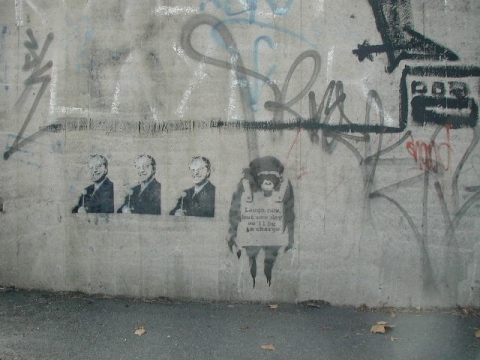
It is long gone, painted over by Yarra City Council. Its disappearance wasn’t remarked by the media. So why is the loss of the ‘little diver’ so noteworthy now? Ah, but wait…. In recent years, Banksy has been the object of much media interest as well as seeing his works suddenly increase in value (in fact, a version on canvas of the same image that I photographed in Richmond in 2003 sold at Bonhams ‘urban art’ auction in London, in February this year, for 80,000 pounds).
And many other stencils and street artworks have also disappeared, without finding themselves to be the subject of news reports or mass ‘mourning’. Why is their loss not so noteworthy? Works have been put up by local and visiting artists all over Melbourne, only for them to be painted over, or torn down, and thus vanish. Perhaps it’s only the disappearance of Banksy’s work that merits comment in the mainstream media?
I also suspect that the media is reporting on this because the work appears to have been destroyed by an individual who can be portrayed as a ‘vandal’. As I mentioned, Yarra City Council painted over Banksy’s apron-wearing ape, along with rats such as this one…

When a council, or a property owner, buffs street artworks or graffiti, the media doesn’t represent them as ‘vandalising’ the images – instead, no doubt the council would be seen as exercising its ‘graffiti management strategy’ and a property owner would be ‘cleaning’ the surface.
I’m sure a large part of the media’s interest in what has happened to Banksy’s stencil is because it allows them to have their cake and eat it too – they can express regret at the loss of the stencil while implicitly condemning whoever did it.
To me, the whole event brings up a number of issues that are worth thinking about. One relates to the protective plexiglass that was placed over the stencil. The news story that I read stated that it was the building owners who asked for the protective covering; in conversations with people around Melbourne in the past I’ve heard it said that Melbourne City Council decided to protect the stencil. I don’t know which is correct, and in some ways it doesn’t matter, because what interests me is less who put the plexiglass there and more the fact that suddenly there has developed the desire to preserve street artworks along with (apparently) the technology to do so.
I started thinking about this recent phenomenon back in July, when I visited Cargo in London. Cargo is a desperately hip bar in Shoreditch, famous for its courtyard area where the walls have been painted by a range of street artists. Some of its panels get painted over as different artists visit: for example, in July there was a fantastic panel painted by Logan Hicks; by October when I went back, it had gone and a new piece was up instead. Exceptions to this process of renewal are two panels by Banksy, which have been covered in plexiglass. You can see one of these here (and in the photo you can see some weird reflections caused by the plexiglass covering):
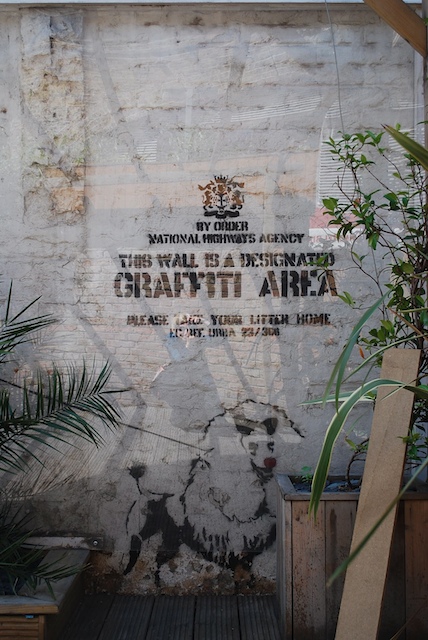
The Cargo courtyard demonstrates the emergence of a hierarchy in the way mainstream culture is responding to street art. It’s a hierarchy that is clearly related to ‘the Banksy effect’, in which Banksy’s works are treated differently than others (they sell for more money, they are the subject of more media interest, they are ‘protected’ where others are not).
Leaving the ‘Banksy effect’ aside (and I’m not trying to be critical of Banksy here, since this phenomenon has arisen mainly through the responses of others to his work rather than through direct actions of his own), is the desire to ‘preserve’ street art a good thing?
I have to say I’m suspicious of what the plexiglass represents. It seems like an attempt to pin down something that shouldn’t be ‘frozen’ in this way. And am I sad at the loss of the little diver stencil? I know I have expressed sadness at ‘losing’ an image in the past (see the entry ‘Losing the image’ in October this year), but in this instance I am much more ambivalent. I think what has been done to the image draws our attention to the plexiglass as much as it destroys the image behind it. As such, if it makes people think about what hypocrisy might be present when one work (or the works of just one artist) can be placed behind plexiglass, then perhaps that will assist the public debate that still needs to take place around street art. And as for whether this is an act of ‘vandalism’, well, in some ways it might be, but if we take a moment to look at what has actually been done, then it’s a little more complex than that.
How can we read the meaning of writing ‘Banksy woz ere’? Well, it is quite a funny, literal, demonstration of what has happened. A Banksy stencil was here, and now these words are here instead. Or, Banksy himself was here in person, and is now gone. And of course ‘Banksy woz ere’ evokes the famous ‘Kilroy was here’ graffiti of the 1970s onwards, in which an anonymous male character seemed to travel the world, leaving only his enigmatic images on walls. A bit like Banksy, really.
So if the stencil had to disappear (and most street artworks will disappear, some day, one way or another), then this might not be a bad way to go.
Fade to grey
Recently I wrote about buffing, the different ways in which councils, governments and property owners seek to erase any graffiti or street art that has been added to a wall or surface.
For many works of street art, the buff represents their fate, sometimes far sooner than the artist would like. One day the image is there, next day it’s gone – painted over, scraped off.
But sometimes an image evades the buff and remains in place for a long, long time. Its longevity might derive from its being tucked away in a hard-to-notice spot, so that years go by and the work has actually only been seen by a few people. Or it might have been placed somewhere that’s hard to reach – hard for the artist who put it there, but also hard for any cleaning crew, which means that a work can stay up for years. And sometimes, even when a work is prominently visible, easy to access, and illegally located, it somehow escapes the buff, and just slowly and gradually disappears, fading back into the stone.
Within street art culture, there seems to be a lot of admiration, and often rightly so, for newly painted work: images that look glossy and shiny, which haven’t been weathered or degraded in any way (by the addition of tags or the application of posters on top, for example). And I’ve heard people say that work which is fading ‘looks old’, ‘tired’ and so on, and to a certain extent that’s true.
But some artists like to see the effects of these external forces and circumstances on their artworks. Miso, for example, is interested in the peeling and fraying that can arise when a pasted-up image experiences the effects of hot sun, rain, wind. And JR’s pasted-up photographic posters register the impact of the environment pretty fast – his work on the façade of the Tate Modern was repaired by the gallery after only a matter of weeks in place, thanks to a damp British summer. For these artists, though, the possibility of deterioration isn’t a problem, but is rather an integral part of their artistic practice – it’s something they actively invite.
Beyond this, though, I think it’s also worth looking at fading artworks, even when that gradual disappearance and deterioration isn’t part of the artist’s stated intentions. It takes quite a time for a painted work on stone to fade – usually months or even years, which means these greying images have a lifespan that’s quite remarkable given the frequency of buffing and going-over by other artists.
Here’s a fading Banksy. To see the remains of it, it’s best to click on the image to make it bigger. Look at the top step, where there are some words still faintly visible:

It reads ‘designated picnic area’ and is stencilled on the steps of an office building in a busy road in Shoreditch in London. It’s scarcely legible now, almost vanished back into the steps, its humour and incongruity about to depart the scene.
And take a look at this one:
It looks like a red smudge on the pavement, but it’s the remains of another Banksy. If you look more closely at the wall next to the smudge, you can see the traces of the two rats stencilled on the walls:
These rats were kitted out as waiters in a fancy restaurant, with the red smudge actually a red carpet. The rats have faded more than the red carpet, and you need to know what was there in order to make sense of what remains. I’m indebted in this respect to Martin Bull’s useful little book, Banksy Locations and Tours (details available from his website), which has a photograph of the work before it started to fade.
So how should we make sense of the fading artwork? Do we dismiss it as occupying some transitional zone between ‘freshness’ and oblivion? Do we paint over it so that new work can take its place? Does its faded nature mean that it is no longer worth noticing or thinking about?
In some ways, I think it’s the very ‘in between-ness’ of the fading image that makes it interesting. Not quite here and not quite gone, maybe having an almost historical value as a record of what was done in the past, but gradually relinquishing any claim on our attention amidst the visual hubbub of the contemporary city. So next time you walk through the streets, perhaps it’s worth paying homage to these fading images, these survivors who have, through chance or circumstance, escaped both the buff and the privileging of the new work of art.
 Comments (2)
Comments (2)

